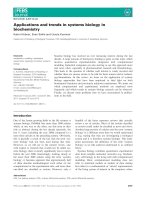Tài liệu Báo cáo khoa học: "MACHINE-READABLE AND DICTIONARIES, THE LEXICAL SYSTEM DATA BASES" pdf
Bạn đang xem bản rút gọn của tài liệu. Xem và tải ngay bản đầy đủ của tài liệu tại đây (76.83 KB, 1 trang )
MACHINE-READABLE DICTIONARIES, LEXICAL DATA BASES
AND THE LEXICAL SYSTEM
Nicoletts Calsolsri
Dipartimento dl Lingu|stica, Universita dl Plsa, Pisa, ITALY
Istituto di Linguistics Cornputssionsle del CNR, Piss, ITALY
I should like to raise some issues concerning the conversion
from a traditional Marhine-Readable Dictionary (MRD) on tape
to a Lexical Data Base (LDB), in order to highlight some
important consequences for computational linguistics which can
follow from this transition. The enormous potentialities of the
information implicitly stored in a standard printed dictionary
or a MRD can only be evidenced and made explicit when the
same data are given a new logical structure in a data base
model, and exploited by appropriate software.
A suitable use of DB methodology is a good starting point to
discover several kinds of lexical, morphological, syntactic, and
semantic relationships between lexieal entries which would
otherwise have remained unexploited. Moreover, the
transformation of a "very large-scale" MRD into a LDB
provides the means of operating throughout the lexicon in a
really extensive manner. I think in fact that an "almost
exhaustive" approach to lexical facts is essential both for
reliable investigations of a lexical system, and for many kinds of
linguistic applications which cannot be restricted to a particular
domain of discourse.
The possibility of abstracting significant regularities from
recurrent patterns of natural language definitions by means of
suitable computational methods, and of reaching a
formalization of a number of important structuring relations
within the lexicon will be discussed. An overview of the
"associative links" already produced in the Italian LDB, and of
other allowable interconnections will be given.
In a "relational" organization of a computerized dictionary
with complex interlinked structures, each word acquires its
meaning as a result of its position in some of the partitionings
created by the formalized relations. When an entry is
activated, all of its relations with other entries can be activated,
too. Conversely, when a relation is activated, all of its linked
concepts are made immediately available. Conceptual and
linguistic information at many levels is thus interactively
retrievable from the LDB following the appropriate pointers.
I shall especially take into consideration those types of
relations which can be of relevance not only for
"Computational Lexicology" research, but also in a more
general Computational Linguistics framework. An example is
provided by derivational relationships which, when formalized,
give rise to families of semantically and syntactically connected
entries, linked to the same base-word node, and substitutable in
different syntactic formulations of the same conceptual
meanings. Another example concerns ease or argument
relations, both (a) between lexieal items, and (b) governed by
lexical items. From (a) 1 expect to achieve, from the natural
language definitions, useful information on the different
lexicalizatons of ease-slot fillers in the case-frames of typical
actions. In contrast, with (b) I can establish an encoding with
each entry-and often with each word sense-of information on
its surface and deep case-argument structure. The utility of the
extensive inclusion of similar information in a LDB which
should be the input for a lexically driven parser, for machine
translation, etc., is obvious.
As a conclusion, it should be pointed out how a LDB must be
considered at the crossroad between texts and system, and in
this perspective some essential properties of a LDB must be
stressed. A first property is "multifunctionalism"; it is
connected to the role of interfaces to the LDB. We must tend
towards creating 'a single' integrated system which, through
many different interfaces, can be adopted for all the range of
possible applications, and by all the possible users, where user
means both a human user and a computer program. Another
important property is that of being "multi-perspective." This
property of multiple access can create something like a
constellation of sublexicons, which altogether capture the many
possible structures which can be observed in the lexical system,
along many dimensions of relatedness. The mediating function
of a LDB between system and texts can thus be considered as
the mapping of lexical structures, of many kinds, on linear
unstructured texts.
460









